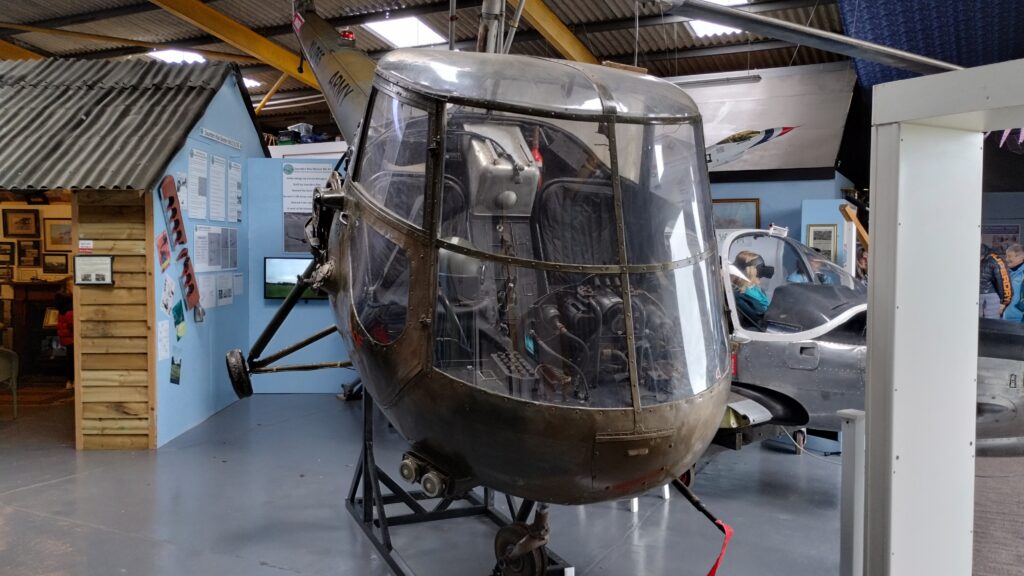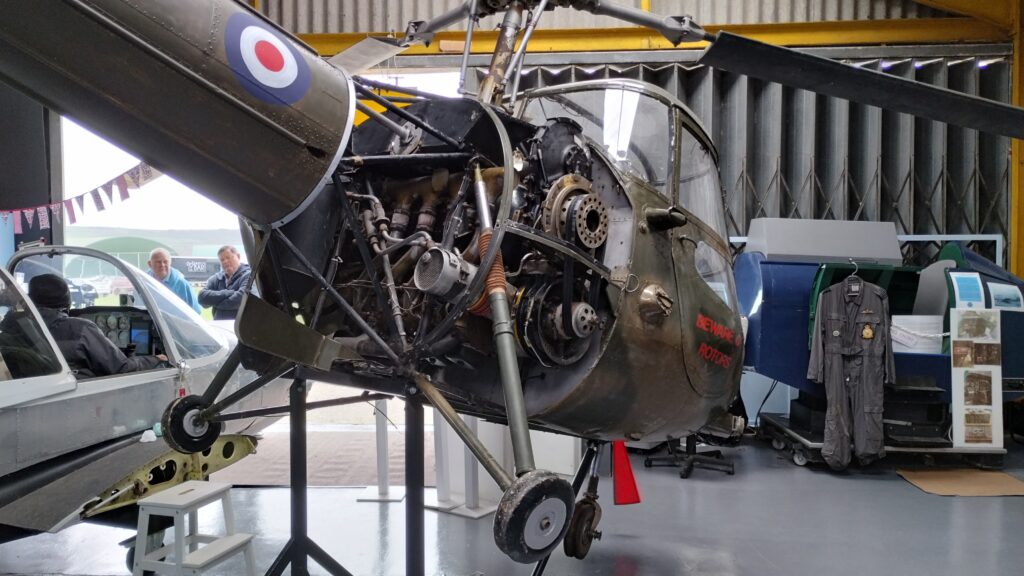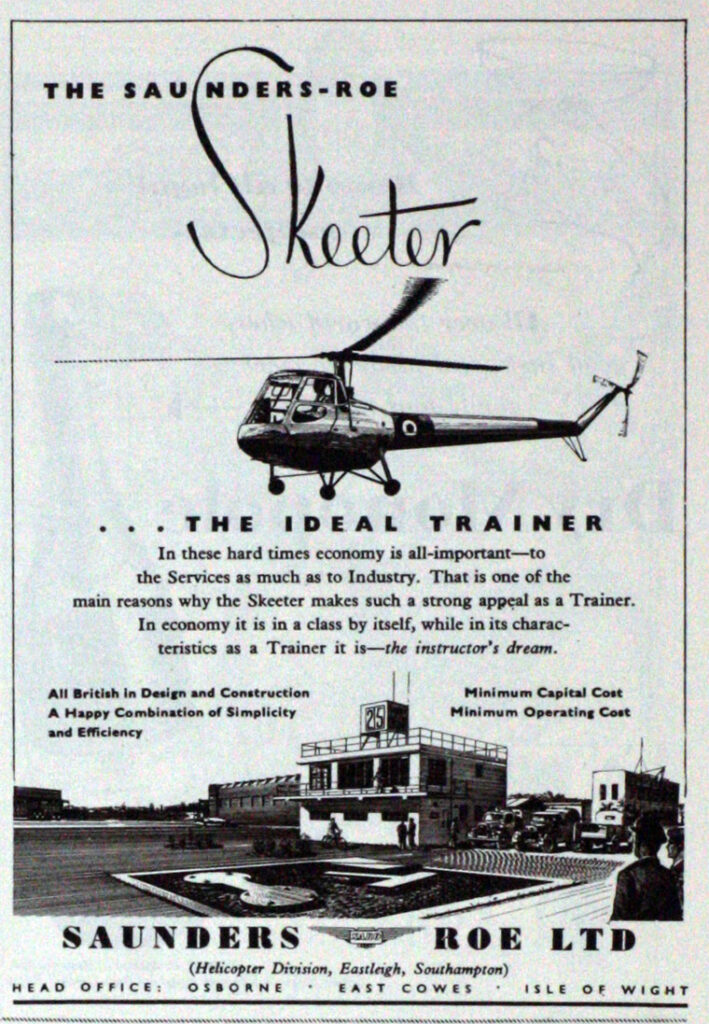The Wight Aviation Museum has been kindly donated an original 1950’s Skeeter Helicopter Reg: XL765 which is now on display in the museum having been cleaned and spruced-up by our team of volunteers.

The Skeeter is mounted on a custom built display stand in the dynamic “taking off” position. There is also a new display area giving visitors a history of these mini flying marvels that were in service for over 10 years from the mid 1950’s.
Skeeter XL765 was a type AOP.12 (Air Observation Post) and is believed to have entered service in 1956. The Skeeter was used by the Air Observation Post unit by the British Army Air Corps and as a training helicopter for the Royal Air Force.
The engine panels have been left off to enable visitors to inspect the engine & ancillary equipment.

History of the Skeeter Helicopter
The Saunders-Roe Skeeter was a two-seat training and scout helicopter that was developed and produced by British manufacturer Saunders-Roe (“Saro”) of Cowes and Southampton, in the United Kingdom.
1947 – The Skeeter is born..
In 1947, the Cierva Autogiro Company commenced work on a new project, which was designated as the W.14 Skeeter. It was a relatively compact two-seat helicopter, intended to be suitable for use as both a civilian aircraft and for aerial observation duties with military customers. The original engine selected to power the Skeeter was a single 110 hp Jameson FF-1 air-cooled horizontally-opposed piston engine.
On 10 October 1948, the first prototype Skeeter performed its maiden flight at Eastleigh airfield. Initial flight trials of the prototype proved the rotorcraft to be underpowered, which was partially as a result of the experimental Jameson engine being prone to overheating. In response, the company decided to develop an improved Mark 2 Skeeter which was to be equipped with the well-established de Havilland Gipsy Major 10, which provided 145 hp (108 kW). The Mark 2 Skeeter was a noticeably larger aircraft and had a different appearance.
1949 – First Flight..
On 20 October 1949, the larger Skeeter Mark 2 performed its first flight. Powered tests using the rotorcraft soon made it apparent that the Mark 2 suffered from severe ground resonance problems. Cierva found it difficult to resolve these issues; on 26 June 1950, the Skeeter Mark 2 was destroyed during ground testing.
Despite these problems, Cierva had received an order from the British Ministry of Supply for three improved Skeeters, a pair of Mark 3s and a single Mark 4, for evaluation purposes by the Royal Air Force (RAF) and Royal Navy.
1951 – Saunders Roe take over..
Prior to the completion of any of these three rotorcraft, rival manufacturer Saunders-Roe completed its take over of Cierva’s helicopter development contracts and took control of its facilities and development programmes in January 1951. Saunders-Roe’s decided to continue Cierva’s projects, including the Skeeter.

Despite an initial preference for the rival Fairey Ultra-light Helicopter from the British Army, which had already been ordered, there was a reversal of fortune with interest from the Bundeswehr in the potential procurement of a large number of Skeeters.
This led to the British order for the Ultra-light Helicopter being cancelled and the Skeeter effectively taking its place, which also served to guarantee an export order from Germany.
During the late 1950s, the Skeeter entered service with the British Army Air Corps, the German Navy, and the German Army. It has the distinction of being the first helicopter to be used by the Army Air Corps.
While some consideration had been made to developing a version of the Skeeter powered by a turbine engine instead of a piston engine, it was decided to produce the developmental Saro P.531 for this purpose instead of a more direct Skeeter derivative.
Despite these problems, order from the British Ministry of Supply was placed for three improved Skeeters, a pair of Mark 3s and a single Mark 4, for evaluation purposes by the Royal Air Force (RAF) and Royal Navy.
During March 1953, the Blackburn Bombardier-engined Skeeter Mark 3B was transferred to the Aeroplane and Armament Experimental Establishment (A&AEE). Subsequent testing showed that these aircraft continued to be underpowered and that the previously encountered ground resonance problems had yet to be properly resolved; these failings were cited as the reason for official support for the rotorcraft being suspended.
In response to the suspension, Saunders-Roe chose to undertake a lengthy series of company-funded tests, which involved the use of a specially-built rig as well as more theoretical work being performed, for the purpose of identifying both the causes of and solutions to the resonance issue.
In 1956, Saunders-Roe finally received production orders for 64 AOP.12s, each powered by a215 hp (160 kW) engine; with production deliveries of the Skeeter commencing in 1958.
General characteristics:
Crew: Two
Length: 26 ft 8 in (8.13 m)
Height: 9 ft 6 in (2.90 m)
Empty weight: 1,656 lb (751 kg)
Gross weight: 2,200 lb (998 kg)
Max takeoff weight: 2,300 lb (1,043 kg)
Powerplant: 1 × de Havilland Gipsy Major 215 4-cylinder air-cooled inverted engine, 215 hp (160 kW)
Main rotor diameter: 32 ft 0 in (9.75 m)
Main rotor area: 804 sq ft (74.7 m2)
Performance
Maximum speed: 109 mph (175 km/h, 95 kn)
Cruise speed: 106 mph (171 km/h, 92 kn)
Range: 260 mi (420 km, 230 nmi) at 86 mph (75 kn; 138 km/h)
Endurance: 3 hr
Service ceiling: 12,800 ft (3,900 m)
Rate of climb: 1,150 ft/min (5.8 m/s)
Hover ceiling: 5,500 ft (1,700 m) (in ground effect)
Vertical climb rate: 425 ft/min (2.16 m/s)
